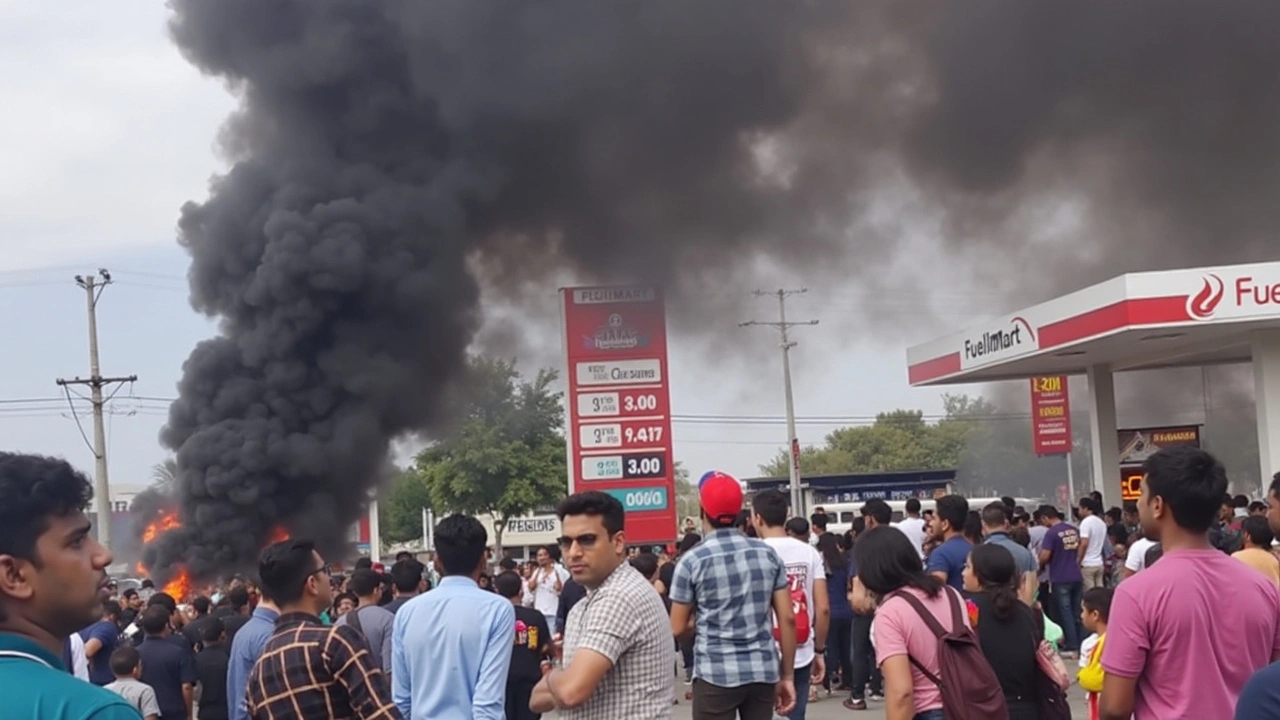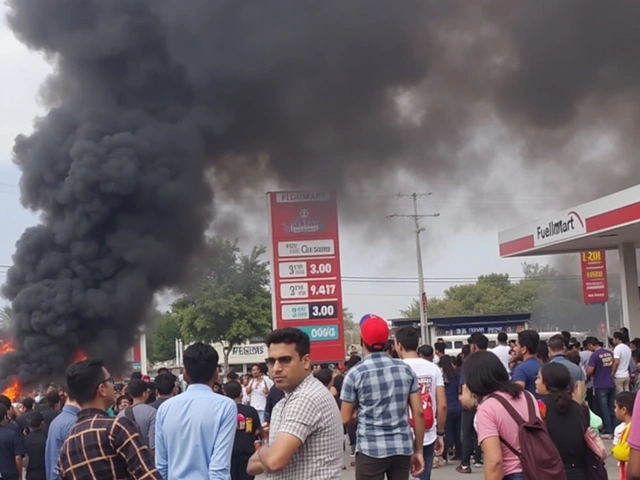Unrest Among Students Following Traffic Tragedies
Protests have engulfed Chuka University in a quest for safer roads. The academic community is up in arms because of a string of alarming traffic accidents that have dangerously unfolded near the campus. The most recent, a heart-wrenching accident leading to the untimely demise of a beloved student, has set off a ripple of outrage among the student body. The tragic event saw the student losing their life after a vehicle struck them on the notorious section of the highway, which has long been a treacherous passage for commuters and pedestrians alike. In an impassioned response, protesters took to the streets, funneling their grief and anger into a loud, distinct demand for change. Blocking the bustling highway, they have drawn attention to the pressing need for immediate action by the authorities.
The Call for Action and Reform
The students' demands are succinct and clear: they want improved road safety measures, not merely promises of improvement or assurances that action will be taken in the future. Their primary objective lies in highlighting the hazardous nature of the roads that snake through their university's vicinity. These roads have quickly become infamous as sites of frequent accidents, which claim lives and sow seeds of fear among students and other local residents. The vivid scenes the protestors create by blocking roads and disrupting traffic speak volumes of a community driven by both grief and the desperate need for protection against unpredictable danger.
The Urgent Cry for Safer Roads
In the days following the accident, the main highway near Chuka University has become an epicenter of activity, both in spirit of protest and calls for reform. Students have voiced emphatic pleas that resonate with a wider issue faced by many young individuals who venture beyond the perceived sanctity of university borders. The adversity they face transcends into a broader narrative of young lives cut short by preventable tragedies, thereby amplifying the call for change to a more national backdrop. They irrevocably feel the burden of being more than just learners; they stand as activists pursuing road safety for all. Their actions exemplify the desperate demand for traffic rules and regulations strong enough to protect lives, particularly in areas surrounding educational institutions where youthful vibrancy pulses through the atmosphere.
Seeking Government Intervention
As traffic halts amidst protests, the pressure swells on local and national governments to address these burgeoning concerns. The responsible management and regulation of roadways naturally falls under the jurisdiction of municipal authorities who now find themselves in a position to provide solutions that exceed mere bandaid fixes. The student demand for advanced pedestrian crossings, speed bumps, consistent policing, and maintenance of traffic lights reflect an urgent need for infrastructure that acknowledges the pedestrian heavy zones near and within university perimeters. Students base their demands on a model for better-prepared roads, focusing on creative but effective countermeasures that ensure further tragic incidents are significantly minimized, or better yet, eradicated entirely.
The Social Cost of Inaction
The thick tension in the air at Chuka University carries the distinct message that the inaction or delayed response of governing bodies will exacerbate an already perilous situation. In their resilience, students display heartbreaking testimonies and reflections, reminding decision-makers of the very real human cost if applicable safety measures are not reinforced with a sense of urgency. Their unified call emphasizes an accountability demand where even one more life lost equates to far too many. This surge of unrest serves as a pivotal spotlight on how merged responsibilities between constituents and authorities can forge safer passage where otherwise there would lie chaos, desolation, and grief.
Rallying for a Hopeful Future
Desperation has given birth to determination as students unite in a solidarity powerful enough to demand that their shared voice is heard. At the heart of their movement lies a wishful aspiration for a future where no one's educational journey is stunted by the shadow of highway peril. This singularly strong current of hope for creating fortified zones around educational podiums brings communities together, channeling dialogue into productive steps toward resolution. Positive change socially, logistically, and politically remains the end goal of these poignant protests as students and activists tirelessly rally for a complete overhaul ensuring that roads leading to knowledge never become roads to oblivion again.



Comments
Stay safe everyone 🙏
The tragedy that unfolded near Chuka University serves as a stark reminder that the very arteries of our society, the roads we traverse daily, are more than mere slabs of asphalt; they are the lifelines that bind communities, economies, and futures together, and when they falter, the ripple effects can be felt far beyond the immediate loss of a single precious life. In the tapestry of human experience, each student's journey is a unique thread, and when a thread is abruptly cut by an avoidable accident, the pattern of collective progress is left with a gaping void that cannot be easily mended. It is within this context that we must examine the systemic factors that have allowed hazardous conditions to persist: inadequate signage, the absence of clearly marked pedestrian crossings, and a troubling lack of consistent law enforcement that together create a perfect storm of danger. Moreover, the cultural attitudes toward speed and assertiveness on the road often glorify recklessness, further exacerbating the risk for vulnerable road users, especially those who, like university students, must navigate these pathways between lectures and homes. Historically, societies that have prioritized the safety of pedestrians and cyclists have reaped benefits in public health, reduced congestion, and a heightened sense of communal responsibility, suggesting that the reforms demanded by the students are not merely aspirational but grounded in proven outcomes. The call for speed bumps, proper lighting, and regular maintenance of traffic signals is therefore not an indulgent wish but a pragmatic strategy backed by data from numerous global case studies where similar interventions have led to measurable declines in accident rates. Additionally, the integration of community-driven monitoring, perhaps through student-led safety audits, could empower the very stakeholders most affected while fostering a collaborative relationship between the university, local authorities, and residents. While recognizing the urgency of these measures, it is equally important to acknowledge the bureaucratic challenges that often slow policy implementation, a reality that underscores the necessity of sustained advocacy and transparent dialogue. The students' resolve to block the highway symbolically disrupts the daily rhythm, compelling policymakers to confront the uncomfortable truth that inaction carries a heavier price than the temporary inconvenience of protests. In sum, the path forward demands a multi-faceted approach: technical upgrades to infrastructure, cultural shifts toward road safety, and institutional accountability, each reinforcing the other to create a safer environment for all who depend on these vital routes.
It’s clear that our roads need serious upgrades; students aren’t asking for luxury, just basic safety that any responsible nation provides.
From a broader perspective, the safety concerns expressed by the Chuka University community echo a universal challenge: balancing rapid development with adequate public infrastructure. While the urgency of immediate measures-such as improved crosswalks and speed controls-is evident, a longer‑term strategic plan involving stakeholder consultation could ensure sustainable solutions. Engaging local authorities, university administration, and civil society in a coordinated effort may also foster a sense of shared responsibility.
Really feeling the pain of those families
We need better lighting and clear signs
Every student deserves a safe walk home
The whole thing looks staged to me; the media loves a protest narrative, but the real puppet‑masters are the corporations that profit from unsafe roads and the bureaucrats who ignore the cries because they’re paid off. Wake up, people.